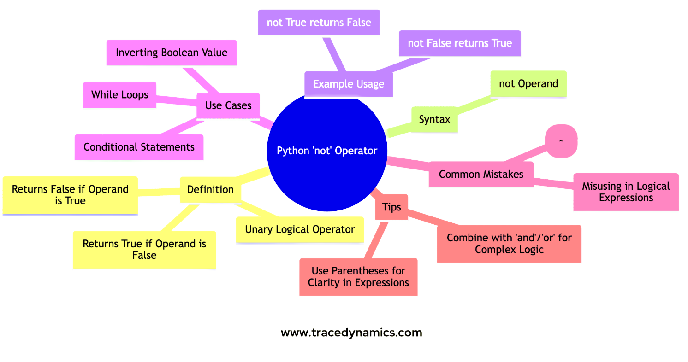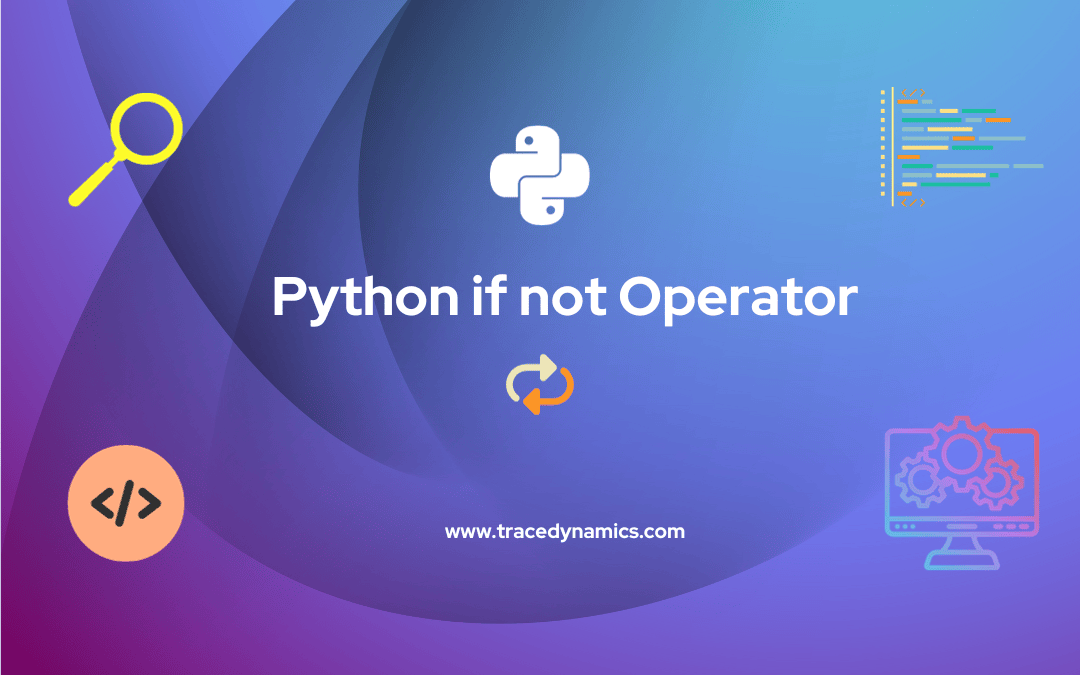In the realm of programming, making decisions based on certain conditions is a core aspect of writing effective and functional code. Python, a highly intuitive and powerful programming language, offers a range of operators and statements to aid in this process. Among these, the combination of if statement and not operator, expressed as if not, is a potent duo that provides developers with a robust mechanism for handling conditional logic. This article dives into the intriguing world of if not in Python, shedding light on its syntax, usage, and real-world applications.
Key Takeaways:
- Understanding the synergy between if and not in Python.
- Grasping the syntax and common usage scenarios of if not.
- Exploring Boolean and Non-Boolean contexts.
- Uncovering best practices and real-world applications.
- Delving into Frequently Asked Questions surrounding if not.
Introduction to Python if not
Python’s if statement is a fundamental building block that allows for conditional execution of code. It evaluates a condition, and if the condition is true, the code within the block is executed. On the flip side, the not operator is a logical operator that reverses the truth value of the condition it precedes. When used together, if not provides a means to execute code if a particular condition is false.

Syntax and Basic Usage
The syntax of if not is straightforward. It combines the if statement with the not operator to form a condition that is negated. Here’s a simple illustration of its syntax:
if not condition:
statement(s)
In the following example, the if not statement is used to check whether a number is less than zero, and if so, a message is printed to the console:
while True:
user_input = input("Enter 'q' to quit: ")
if not user_input != 'q':
break
Output:
The number is negative
This simple example showcases the essence of if not in action – negating a condition and executing code based on that negation.
Exploring Boolean Contexts
The utility of if not extends beyond simple condition negation. It finds a significant application in Boolean contexts, where it can be employed to check for truthiness or falsiness of values, and act accordingly.
Usage with while Loops
In Python, the while loop continues execution as long as a specified condition remains true. However, with the use of if not, you can create loops that continue execution until a certain condition becomes false. This is particularly useful in scenarios where you need to monitor a particular state or wait for a certain condition to cease.
while True:
user_input = input("Enter 'q' to quit: ")
if not user_input != 'q':
break
In this snippet, the if not statement is used to break out of the while loop once the user enters ‘q’.
Testing for Membership
Python’s if not can also be employed to test for membership within collections such as lists, tuples, or dictionaries.
my_list = [1, 2, 3, 4, 5]
if not 6 in my_list:
print("6 is not in the list")
Output:
6 is not in the list
This usage of if not allows for intuitive and readable code when testing for the absence of a particular value within a collection.
Non-Boolean Contexts and Best Practices
The journey with if not does not end with Boolean contexts; it finds relevance in Non-Boolean contexts too, presenting a versatile tool in a developer’s arsenal.
Function-Based not Operator
Python also facilitates a function-based approach to the not operator, which can be handy in certain scenarios, especially when dealing with complex conditions or when needing to negate the output of function calls.
def is_positive(num):
return num > 0
if not is_positive(-5):
print("The number is not positive")
Output:
The number is not positive
This snippet demonstrates a function-based approach to utilizing if not, showcasing its adaptability.
Best Practices
Adhering to best practices when using if not can lead to cleaner, more readable code. Some recommended practices include:
- Avoiding double negatives as they can lead to code that is hard to understand.
- Being explicit in your conditions to ensure code readability and maintainability.
- Using parentheses to clarify order of operations in complex conditions.
Real-world Applications
The practical applications of if not are vast and varied, spanning across different domains and use cases.
- Simplifying Conditional Statements: if not can significantly simplify conditional logic, making code more readable and maintainable.
- Input Validation: It is instrumental in validating user input, ensuring that undesirable or incorrect values are properly handled.
Delving into the Syntax and Usage
Understanding the syntax and common usage scenarios of if not is crucial for effectively leveraging this operator in your Python projects.
Syntax of if not
The if not syntax is a fusion of the if statement with the not operator, forming a negated conditional statement. Here’s a refresher on its syntax:
if not condition:
statement(s)
Common Use Cases
age = 15
if not age >= 18:
print("You are not eligible to vote")
- Negating Conditions: Negating a condition to execute code when a condition is false.
- Checking for Empty Collections: Verifying if a collection like a list, tuple, or dictionary is empty.
my_list = []
if not my_list:
print("The list is empty")
- Validating User Input: Ensuring that the user input meets certain criteria.
user_input = input("Enter a positive number: ")
if not user_input.isdigit():
print("Invalid input. Please enter a positive number")
Advanced Usage and Best Practices
Taking if not to the next level involves exploring its utility in non-Boolean contexts and adhering to best practices for clean, efficient code.
Non-Boolean Contexts
In non-Boolean contexts, if not can test the truthiness of values that aren’t strictly True or False. For instance, it treats empty strings, empty collections, and zero values as False.
user_input = input("Enter a positive number: ")
if not user_input.isdigit():
print("Invalid input. Please enter a positive number")
Best Practices
- Avoiding Double Negatives: Steer clear of double negatives as they can muddle the code’s readability.
# Avoid this
if not age != 18:
print("Age is 18")
# Prefer this
if age == 18:
print("Age is 18")
- Explicit Conditions: Strive for explicit conditions to promote code clarity and maintainability.
# Avoid this
if not is_logged_in:
print("Please log in")
# Prefer this
if is_logged_in == False:
print("Please log in")
Practical Applications
The real-world applications of if not are boundless, offering a versatile tool for various programming scenarios.
- Error Handling:if not can be instrumental in error handling by checking for undesirable states.
# Avoid this
if not is_logged_in:
print("Please log in")
# Prefer this
if is_logged_in == False:
print("Please log in")
- Data Validation: It is invaluable for validating data, ensuring that the data meets certain criteria before proceeding.
# Avoid this
data = get_data()
if not data:
print("No data received. Cannot proceed.")
- Control Flow:
if notis a key player in managing the control flow of a program, helping to direct the execution of code based on specified conditions.
These practical applications underscore the value and versatility of the if notoperator in Python, illuminating its capability to simplify and streamline conditional logic in your code. Through a thorough understanding and prudent usage of if not, you can write cleaner, more efficient, and more intuitive code in your Python projects.
Frequently Asked Questions
What does the 'if not' statement do in Python?
In Python, the ‘if not’ statement is used to check if a condition is False. If the condition is False, the code block under ‘if not’ will be executed.
Can 'if not' be used with Boolean values?
Yes, ‘if not’ can be used with Boolean values. It reverses the Boolean value, executing the code block if the value is False.
How does 'if not' work with lists in Python?
‘If not’ checks if a list is empty in Python. If the list is empty, the statement after ‘if not’ gets executed.
Is 'if not' different from 'if' in Python?
‘If not’ in Python is used for negation, checking if a condition is False, whereas ‘if’ checks if a condition is True.
Can 'if not' be combined with 'else' in Python?
Yes, ‘if not’ can be used with an ‘else’ clause in Python. The ‘else’ block executes when the ‘if not’ condition evaluates to False.
How can 'if not' be used with variables?
‘If not’ can be used to check if a variable is None, empty, or False in Python. If the variable meets any of these conditions, the ‘if not’ block will execute.
Can 'if not' be used with strings?
Yes, ‘if not’ can check if a string is empty in Python. It executes the code block if the string is empty.
What is the purpose of using 'if not' in Python?
‘If not’ is used in Python to improve readability and succinctly express a condition that checks for falseness.
Can 'if not' be nested in Python?
Yes, ‘if not’ statements can be nested within other ‘if’ or ‘if not’ statements in Python for more complex conditional logic.
Is 'if not' a common Pythonic way to express conditions?
Yes, using ‘if not’ is a Pythonic way to express conditions that check for False, None, or empty values.

